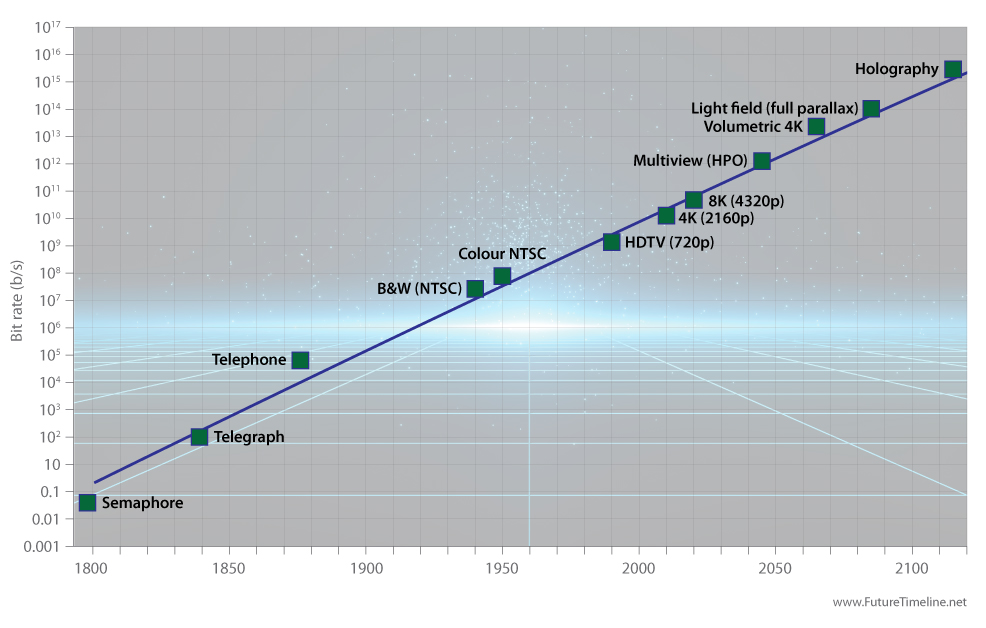
Telecommunications bit rates 1798-2120
This graph shows the progress in telecommunications bit rates over the last two centuries, and a future extrapolation to the 22nd century.
A primitive form of telecommunications emerged in the late 18th century, when French inventor Claude Chappe demonstrated a practical semaphore system that delivered messages between Paris and Lille. Known as the optical telegraph, it had a transmission rate of two to three symbols (196 different types) each minute, or about 0.4 b/s.
The electrical telegraph, popularised in the 1840s, used a coding system developed by American inventor Samuel Morse, which encoded text characters as sequences of two different signal durations, called dots and dashes. It achieved a rate of approximately 100 b/s.
The telephone, patented in 1876 by Scottish-born inventor Alexander Graham Bell, supported voice frequency transmission of up to 64 kb/s, or about 640 times more data than Morse code.
These orders of magnitude increases continued in the 20th century. NTSC black and white electronic televisions, available in the 1940s, had 525 interlaced lines and displayed images at 29.97 frames per second, or a bit rate of 26 Mb/s. The colour NTSC format, introduced 10 years later, tripled the black and white bandwidth to accommodate red, green, and blue channels.
By 1990, high-definition television (HDTV) had emerged with 720p at 1.3 Gb/s (excluding compression), followed by ultra-HDTV 2160p (4K) at 12.7 Gb/s in 2010 and later 4320p (8K) at 47.8 Gb/s, which had its official technical definition in 2020.
With ongoing advances in science and technology, the bit rate for telecommunications is predicted to continue growing exponentially in the future. A study by Pierre-Alexandre Blanche, PhD, from the University of Arizona, appeared in the journal Light: Advanced Manufacturing in December 2021. His paper examines the likely milestones we can expect as new magnitudes of bandwidth become available for broadcasters.

Volumetric 4K future display technology.
Following 8K (and probably 16K in the 2030s), a new standard we can expect by mid-century is known as “multiview”. A display of this type is designed such that the motion parallax can be reproduced smoothly when a viewer’s position changes. It has limitations, however, being horizontal parallax only (HPO) and unable to reproduce its effect to viewers at every possible angle.
After multiview (HPO), Blanche predicts that volumetric 4K will become the standard by around 2065. As pictured above, this will enable the broadcast of fully three-dimensional content in 4K resolution. Rather than seeing a flat image based on the position of pixels along the x and y axis, the screen will extend back to include a z-axis. In other words, pixels will be replaced with voxels, in a 3D space refreshing dozens of times a second. Volumetric displays will have the advantage of being able to reproduce the field depth without resolution loss. The data rate needed for this effect is 1.3×1013 bit/s, or about 1,000 times greater than 2D transmissions.
But as with multiview, volumetric 4K will have limitations. For instance, occlusions will only be correctly reproduced for one point of view. This occurs because the emission of the voxel is omnidirectional, and there is no absorptive voxel, explains Blanche. “Some systems [may] use an eye tracking mechanism to re-calculate occlusions and present the correct image wherever the viewer is located,” he writes. “However, only one correct perspective can be achieved, precluding its application for multiple observers.”
Since volumetric displays are easily scalable, lower-resolution systems could emerge a lot sooner than 2065, he predicts. These will be used to showcase the future potential of this technology, before the arrival of full 4K volumetric.
The next major milestone, assuming the long-term trend holds, will be light field (full parallax). Requiring an order of magnitude higher bit rate, this is predicted to be introduced by the mid-2080s. Using ray-optics and integral imaging, it will provide a far wider range of angles to observe 3D effects, smoothly generating both horizontal and vertical parallaxes – greatly improving the experience for multiple users at varying positions.
The final step in the evolution of television will be holography, rendering all optical cues interpreted by the human visual system. This will effectively mean the perfection of display technology, with all glitches removed. The people and objects on such a television will be eerily lifelike, appearing to exist in their own miniature universe. However, they could even partake in the real world – being projected outside the limited volume of a television set, if desired – much like the “Joi” companion seen in Blade Runner 2049.
Although many recent advances have been demonstrated in research settings, a true holographic 3D system will need a transmission rate of 3×1015 bit/s, according to Professor Blanche, which he predicts for commercial introduction by the year 2115.

Sources:
The future of 3D display and the emergence of holographic television, Phys.org:
https://phys.org/news/2021-12-future-3d-emergence-holographic-television.html
Holography, and the future of 3D display, Light: Advanced Manufacturing:
https://www.light-am.com/article/doi/10.37188/lam.2021.028
Posted: 8th February 2022. Last updated: 8th February 2022.